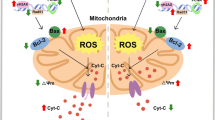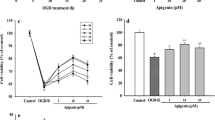Abstract
Background: Edaravone had been validated to effectively protect against ischemic injuries. In this study, we investigated the protective effect of edaravone by observing the effects on anti-apoptosis, regulation of Bcl-2/Bax protein expression and recovering from damage to mitochondria after OGD (oxygen-glucose deprivation)-reperfusion. Methods: Viability of PC12 cells which were injured at different time of OGD injury, was quantified by measuring MTT (2-(4,5-dimethylthiazol-2-yl)-2,5-diphenyltetrazolium bromide) staining. In addition, PC12 cells’ viability was also quantified after their preincubation in different concentration of edaravone for 30 min followed by (OGD). Furthermore, apoptotic population of PC12 cells that reinsulted from OGD-reperfusion with or without preincubation with edaravone was determined by flow cytometer analysis, electron microscope and Hoechst/PI staining. Finally, change of Bcl-2/Bax protein expression was detected by Western blot. Results: (1) The viability of PC12 cells decreased with time (1∼12 h) after OGD. We regarded the model of OGD 2 h, then replacing DMEM (Dulbecco’s Modified Eagle’s Medium) for another 24 h as an OGD-reperfusion in this research. Furthermore, most PC12 cells were in the state of apoptosis after OGD-reperfusion. (2) The viability of PC12 cells preincubated with edaravone at high concentrations (1, 0.1, 0.01 μmol/L) increased significantly with edaravone protecting PC12 cells from apoptosis after OGD-reperfusion injury. (3) Furthermore, edaravone attenuates the damage of OGD-reperfusion on mitochondria and regulated Bcl-2/Bax protein imbalance expression after OGD-reperfusion. Conclusion: Neuroprotective effects of edaravone on ischemic or other brain injuries may be partly mediated through inhibition of Bcl-2/Bax apoptotic pathways by recovering from the damage of mitochondria.
Similar content being viewed by others
References
Amemiya, S., Kamiya, T., Nito, C., Inaba, T., Kato, K., Ueda, M., Shimazaki, K., Katayama, Y., 2005. Anti-apoptotic and neuroprotective effects of edaravone following transient focal ischemia in rats. Eur. J. Pharmacol., 516(2):125–130. [doi:10.1016/j.ejphar.2005.04.036]
Caccamo, D., Campisi, A., Curro, M., Li, V.G., Vanella, A., Ientile, R., 2004. Excitotoxic and post-ischemic neurodegeneration: involvement of transglutaminases. Amino. Acids, 27(3–4):373–379. [doi:10.1007/s00726-004-0117-1]
Ceccatelli, S., Tamm, C., Sleeper, E., Orrenius, S., 2004. Neural stem cells and cell death. Toxicol. Lett., 149(1–3):59–66. [doi:10.1016/j.toxlet.2003.12.060]
Christophe, M., Nicolas, S., 2006. Mitochondria: a target for neuroprotective interventions in cerebral ischemia-reperfusion. Curr. Pharm. Des., 12(6):739–757. [doi:10.2174/138161206775474242]
Chung, T.W., Koo, B.S., Choi, E.G., Kim, M.G., Lee, I.S., Kim, C.H., 2006. Neuroprotective effect of a chuk-me-sun-dan on neurons from ischemic damage and neuronal cell toxicity. Neurochem. Res., 31(1):1–9. [doi:10.1007/s11064-005-9264-3]
Dong, J., Takami, Y., Tanaka, H., Yamaguchi, R., Guo, J.P., Qing, C., Lu, S.L., Shimazaki, S., Ogo, K., 2004. Protective effects of a free radical scavenger, MCI-186, on high-glucose-induced dysfunction of human dermal microvascular endothelial cells. Wound Repair Regen., 12(6):607–612. [doi:10.1111/j.1067-1927.2004.12607.x]
Gross, A., 2005. Mitochondrial carrier homolog 2: a clue to cracking the bcl-2 family riddle. J. Bioenerg. Biomembr., 37(3):113–119. [doi:10.1007/s10863-005-6222-3]
Hoehn, B., Yenari, M.A., Sapolsky, R.M., Stemberg, G.K., 2003. Glutathione peroxidase overexpression inhibits cytochrome C release and proapoptotic mediators to protect neurons from experimental stroke. Stroke, 34(10):2489–2494. [doi:10.1161/01.STR.0000091268.25816.19]
Iijima, T., Mishima, T., Akagawa, K., Iwao, Y., 2003. Mitochondrial hyperpolarization after transient oxygen-glucose deprivation and subsequent apoptosis in cultured rat hippocampal neurons. Brain Res., 993(1–2):140–145. [doi:10.1016/j.brainres.2003.09.041]
Kim, R., Emi, M., Tanabe, K., 2006. Role of mitochondria as the gardens of cell death. Cancer Chemother. Pharmacol., 57(5):545–553. [doi:10.1007/s00280-005-0111-7]
Kokura, S., Yoshida, N., Sakamoto, N., Ishikawa, T., Takagi, T., Higashihara, H., Nakabe, N., Handa, O., Naito, Y., Yoshikawa, T., 2005. The radical scavenger edaravone enhances the anti-tumor effects of CPT-11 in murine colon cancer by increasing apoptosis via inhibition of NF-kB. Cancer Lett., 229(2):223–233. [doi:10.1016/j.canlet.2005.06.039]
Lee, J.H., Park, S.Y., Lee, W.S., Hong, K.W., 2005. Lack of antiapoptotic effects of antiplatelet drug, aspirin and clopidogrel, and antioxidant, MCI-186, against focal ischemic brain damage in rats. Neurol. Res., 27(5):483–492. [doi:10.1179/016164105X17134]
Margaill, I., Plotkine, M., Lerouet, D., 2005. Antioxidant strategies in the treatment of stroke. Free Radical Biol. Med., 39(4):429–443. [doi:10.1016/j.freeradbiomed.2005.05.003]
Montell, C., 2005. The latest waves in calcium signaling. Cell, 122(2):157–163. [doi:10.1016/j.cell.2005.07.009]
Nagashima, T., Wu, S., Ikeda, K., Tamaki, N., 2000. The role of nitric oxide in reoxygenation injury of brain microvascular endothelial cells. Acta Neurochir. Suppl., 76: 471–473.
Noor, J.I., Ikeda, T., Ueda, Y., Ikenoue, T., 2005. A free radical scavenger, edaravone, inhibits lipid peroxidation and the production of nitric oxide in hypoxic-ischemic brain damage of neonatal rats. Am. J. Obstet. Gynecol., 193(5):1703–1708. [doi:10.1016/j.ajog.2005.03.069]
Okatani, Y., Wakatsuki, A., Enzan, H., Miyahara, Y., 2003. Edaravone protects against ischemia/reperfusion-induced oxidative damage to mitochondria in rat liver. Eur. J. Pharmacol., 465(1–2):163–170. [doi:10.1016/S0014-2999(03)01463-8]
Orrell, R.W., Lane, R.J., Ross, M., 2005. Antioxidant treatment for amyotrophic lateral sclerosis/motor neuron disease. Cochrane. Database Syst. Rev., 25(1):CD002829.
Perier, C., Tieu, K., Gueggan, C., Caspersen, C., Jackson-Lewis, V., Carelli, V., Martinuzzi, A., Hirano, M., Przedborski, S., Vila, M., 2005. Complex I deficiency primes Bax-dependent neuronal apoptosis through mitochondrial oxidative damage. Proc. Natl. Acad. Sci. USA, 102(52):19126–19131. [doi:10.1073/pnas.0508215102]
Rajesh, K.G., Sasaguri, S., Suzuki, R., Maeda, H., 2003. Antioxidant MCI-186 inhibits mitochondrial permeability transition pore and upregulates Bcl-2 expression. Am. J. Physiol. Heart Circ. Physiol., 285(5):H2171–H2178.
Reddy, P.H., 2006. Amyloid precursor protein-mediated free radicals and oxidative damage: implications for the development and progression of Alzheimer’s disease. J. Neurochem., 96(1):1–13. [doi:10.1111/j.1471-4159.2005.03530.x]
Soane, L., Fiskum, G., 2005. Inhibition of mitochondrial neural cell death pathways by protein transduction of bcl-2 family proteins. J. Bioenerg. Biomembr., 37(3):179–190. [doi:10.1007/s10863-005-6590-8]
Stoy, N., Mackay, G.M., Forrest, C.M., Christofides, J., Egerton, M., Stone, T.W., Darlington, L.G., 2005. Tryptophan metabolism and oxidative stress in patients with Huntington’s disease. J. Neurochem., 93(3):611–623. [doi:10.1111/j.1471-4159.2005.03070.x]
Suzuki, K., Kazui, T., Terada, H., Umemura, K., Ikeda, Y., Bashar, A.H., Yamashita, K., Washiyama, N., Suzuki, T., Ohkura, K., Yasuike, J., 2005. Experimental study on the protective effects of edaravone against ischemic spinal cord injury. J. Thorac. Cardiovasc. Surg., 130(6):1586–1592. [doi:10.1016/j.jtcvs.2005.08.049]
Takuma, K., Kiriu, M., Mori, K., Lee, E., Enomoto, R., Baba, A., Matsuda, T., 2003. Roles of cathepsins in reperfusion-induced apoptosis in cultured astrocytes. Neurochem. Int., 42(2):153–159. [doi:10.1016/S0197-0186(02)00077-3]
Won, S.J., Kim, D.Y., Gwag, B.J., 2002. Cellular and molecular pathways of ischemic neuronal death. J. Biochem. Mol. Biol., 35(1):67–86.
Yasuoka, N., Nakajima, W., Ishida, A., Takada, G., 2004. Neuroprotection of edaravone on hypoxic-ischemic brain injury in neonatal rats. Brain Res. Dev. Brain Res., 151(1–2):129–139. [doi:10.1016/j.devbrainres.2004.04.006]
Zhou, J., Fu, Y., Tang, X.C., 2001. Huperzine A protects rat pheochromocytoma cells against oxygen-glucose deprivation. Neuroreport, 12(10):2073–2077. [doi:10.1097/00001756-200107200-00007]
Author information
Authors and Affiliations
Corresponding author
Additional information
Project (No. 2005C30059) supported by the Science and Technology Program of Zhejiang Province, China
Rights and permissions
About this article
Cite this article
Song, Y., Li, M., Li, Jc. et al. Edaravone protects PC12 cells from ischemic-like injury via attenuating the damage to mitochondria. J. Zhejiang Univ. - Sci. B 7, 749–756 (2006). https://doi.org/10.1631/jzus.2006.B0749
Received:
Accepted:
Issue Date:
DOI: https://doi.org/10.1631/jzus.2006.B0749
Key words
- Edaravone
- Ischemia
- Apoptosis
- Rat pheochromocytoma (PC12) cells
- Mitochondria
- Bax
- Bcl-2
- Oxygen-glucose deprivation (OGD)




